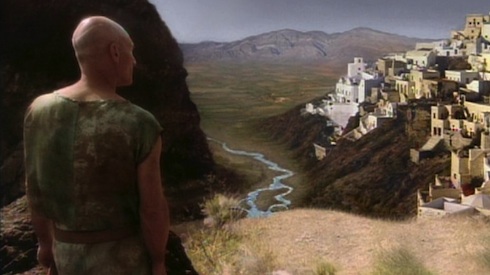On Friday at New York Comic Con in a little lecture hall underneath an escalator (and next door to a standing-room only DC animation presentation) was a hidden science fiction gem. Here, writer Morgan Gendel was hanging out and talking candidly about what is possibly the best episode of Star Trek: The Next Generation, “The Inner Light.” Being someone who is pretty familiar with Star Trek, I wasn’t sure what to expect from this lecture. Would I learn anything new? Would it be dull and ruin my positive feelings about an episode that had a big impact on me?
What I got was an insightful hour-long anecdote about how, sometimes, the most resonate and beloved stories within a shared universe come from an outsider. With “The Inner Light,” that outsider was Morgan Gendel.
In his presentation about “The Inner Light” Gendel emphasized that he was very much not part of the Star Trek: The Next Generation writing circle, noting that he had pitched episode ideas to the show numerous times before “The Inner Light” was picked up. One of his earlier concepts involved the Enterprise crew encountering a planet populated by a race who had to tell the truth all the time. Gendel thought this idea was stellar, but later discovered the writer’s room was “sick” of hearing people pitch this exact same premise over and over again.
 Either way, Gendel eventually did get the TNG people onboard with “The Inner Light.” Part of his original impetus to write the story came from a desire to “fuck with the nature of the show.” He found himself wondering why Star Trek didn’t have its characters dealing with average every day problems. “The Inner Light” was his attempt to do just that. Further, Gendel felt that in contrast to the original series, TNG was a little too “buttoned down” and he liked the idea of giving Picard a romance, which made him a little bit more like Kirk. (Gendel’s other TNG episode was “Starship Mine,” which really, really puts Picard in an action role and makes him more like Kirk.)
Either way, Gendel eventually did get the TNG people onboard with “The Inner Light.” Part of his original impetus to write the story came from a desire to “fuck with the nature of the show.” He found himself wondering why Star Trek didn’t have its characters dealing with average every day problems. “The Inner Light” was his attempt to do just that. Further, Gendel felt that in contrast to the original series, TNG was a little too “buttoned down” and he liked the idea of giving Picard a romance, which made him a little bit more like Kirk. (Gendel’s other TNG episode was “Starship Mine,” which really, really puts Picard in an action role and makes him more like Kirk.)
Early versions of Gendel’s script were vastly different from what he ended up writing. Initially, the idea was to have Picard, Riker and Troi in a bizarre non-Enterprise scenario and then only at the end of the story would it have been revealed that it was essentially “all a dream.” This concept kept getting revised, and eventually would focus only on Picard.
Gendel relayed that at its heart “The Inner Light” is ultimately about two things. The first being that because the episode takes place inside of Star Trek it becomes an exercise in how to tell a story within another story. “The Inner Light” takes this notion one step further by having the story of Star Trek itself become a sort of “imagined” story or “dream” to Picard’s alter-ego, Kamin. In this way, the episode is a meditation on the importance of storytelling as a cultural tool because the aliens who sent the probe to Picard are sharing their civilization by telling a story and by recruiting a storyteller and a teacher.
The second major theme of “The Inner Light” seemed to be a bit more personal for Gendel, as he talked about being an outsider to Star Trek and how that resonated in the story itself. Picard is an outsider to the planet Kataan initially. Similarly, the personae he inhabits, Kamin, is an outsider insofar as he is one of the few citizens of the town/planet who is concerned about the drought and the ecological future of the planet in general. Gendel asserted that stories about outsiders who challenge the status quo are important in stirring up emotions and that the reason why this episode resonates so much with people nearly 20 years after it aired is because of the moment when Picard realizes everything in his 50-year life on Katann has been leading to a moment that will connect with his “forgotten” life as Jean-Luc Picard.
The famous flute played by Kamin/Picard in this episode wasn’t initially loved by the powers-that-be at Star Trek. Gendel eventually realized that if he pitched it as a penny whistle then the nautical connection to Star Trek could be preserved. However, there was a period where Morgan Gendel says he was seriously worried they would “lock him out of the building if I ever mentioned ‘Picard’ and ‘flute’ in the same sentence again.”
A story with no traditional conflict, and no discernable villain was a very outsider move for Gendel to pull, and yet, this episode of TNG won the Hugo for Best Dramatic Presentation. The impact of this episode on pop culture is also fairly obvious. Gendel even joked about the story’s similarities to Inception saying, “Come on, everyone has to assume Christopher Nolan has seen ‘The Inner Light.'”
On a personal note, I was able to ask Gendel if the title of episode was taken from the George Harrison-penned Beatles song of the same name. I’m happy to report that he answered in the affirmative, going so far as to say he wanted to try and name his other TNG episode “Revolution” instead of “Starship Mine.”
The content of the song “The Inner Light” was inspired by the 47th Chapter of the Tao Te Ching. Meaning, George Harrison told a story about the Toa Te Ching through a song, which Morgan Gendel, then turned into an episode of Star Trek!
In talking about the Fab Four, Gendel mentioned to me on the sly that he’s actually “more of a Beatles fan, than a Trek fan.” Don’t worry Morgan, I understand. But, for me, because of episodes like “The Inner Light,” it’s a tie.
Ryan Britt is the staff writer for Tor.com. He knows a lot about the Beatles. Maybe a little bit more about Star Trek, but not much.










